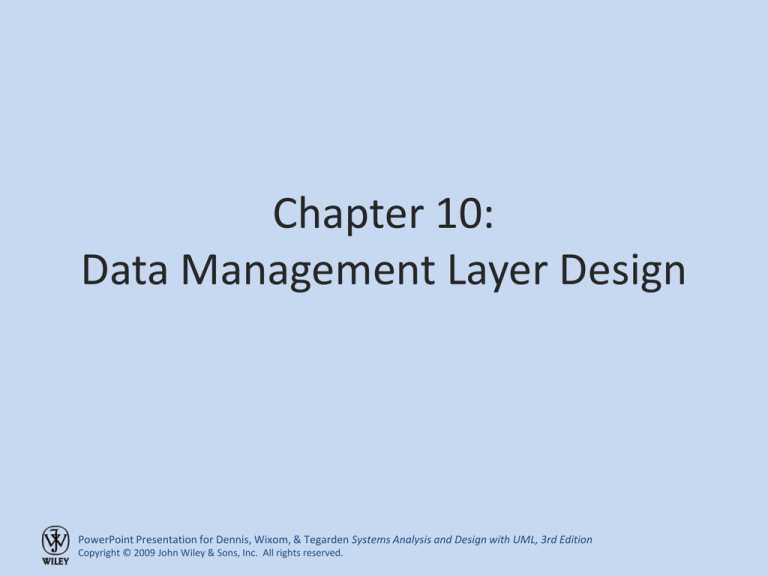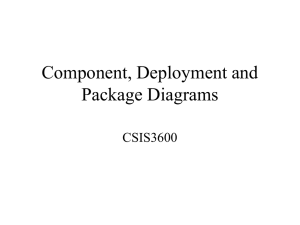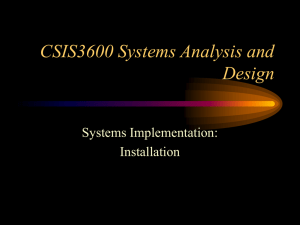
Chapter 10:
Data Management Layer Design
PowerPoint Presentation for Dennis, Wixom, & Tegarden Systems Analysis and Design with UML, 3rd Edition
Copyright © 2009 John Wiley & Sons, Inc. All rights reserved.
Objectives
• Become familiar with several object-persistence formats.
• Be able to map problem domain objects to different objectpersistence formats.
• Be able to apply the steps of normalization to a relational
database.
• Be able to optimize a relational database for object storage
and access.
• Become familiar with indexes for relational databases.
• Be able to estimate the size of a relational database.
• Be able to design the data access and manipulation classes.
PowerPoint Presentation for Dennis, Wixom, & Tegarden Systems Analysis and Design with UML, 3rd Edition
Copyright © 2009 John Wiley & Sons, Inc. All rights reserved.
The Data Management Layer
• Includes both
– data access and manipulation logic, and
– the actual design of the storage
• Four-step design approach
1. Selecting the format of the storage
2. Mapping problem-domain objects to object-persistence
format
3. optimizing the object-persistence format
4. designing the data access & manipulation classes
PowerPoint Presentation for Dennis, Wixom, & Tegarden Systems Analysis and Design with UML, 3rd Edition
Copyright © 2009 John Wiley & Sons, Inc. All rights reserved.
OBJECT PERSISTENCE FORMATS
PowerPoint Presentation for Dennis, Wixom, & Tegarden Systems Analysis and Design with UML, 3rd Edition
Copyright © 2009 John Wiley & Sons, Inc. All rights reserved.
Object Persistence Formats
•
•
•
•
Files (Sequential and Random)
Relational databases
Object-relational databases
Object-oriented databases
PowerPoint Presentation for Dennis, Wixom, & Tegarden Systems Analysis and Design with UML, 3rd Edition
Copyright © 2009 John Wiley & Sons, Inc. All rights reserved.
Sample File
Fictitious customer database
PowerPoint Presentation for Dennis, Wixom, & Tegarden Systems Analysis and Design with UML, 3rd Edition
Copyright © 2009 John Wiley & Sons, Inc. All rights reserved.
Sequential & Random Access Files
• Sequential access files allow sequential
operations
– Read, write, and search
• Efficient for report writing
• Searches are not efficient because an average
of 50% of records have to be accessed
• Two versions
– Ordered
– unordered
PowerPoint Presentation for Dennis, Wixom, & Tegarden Systems Analysis and Design with UML, 3rd Edition
Copyright © 2009 John Wiley & Sons, Inc. All rights reserved.
Random Access Files
• Allow only random or direct file operations
• Good for finding and updating a specific
object
• Inefficient report writing
PowerPoint Presentation for Dennis, Wixom, & Tegarden Systems Analysis and Design with UML, 3rd Edition
Copyright © 2009 John Wiley & Sons, Inc. All rights reserved.
Application File Types
•
•
•
•
•
Master Files
Look-up files
Transaction files
Audit file
History file
PowerPoint Presentation for Dennis, Wixom, & Tegarden Systems Analysis and Design with UML, 3rd Edition
Copyright © 2009 John Wiley & Sons, Inc. All rights reserved.
Relational Databases
• Collection of tables
– Comprised of fields that define entities
– Primary key has unique values in each row of a table
– Foreign key is primary key of another table
• Tables related to each other
– Primary key field of a table is a field of another table and
called a foreign key
– Relationship established by a foreign key of one table
connecting to the primary key of another table
PowerPoint Presentation for Dennis, Wixom, & Tegarden Systems Analysis and Design with UML, 3rd Edition
Copyright © 2009 John Wiley & Sons, Inc. All rights reserved.
Database Management System
• Software that creates and manipulates a
database
• RDBMS is a DBMS for a relational database
• RDBMS usually support Referential Integrity
– the idea of ensuring that values linking the tables
together through the primary and foreign keys are
valid and correctly synchronized
PowerPoint Presentation for Dennis, Wixom, & Tegarden Systems Analysis and Design with UML, 3rd Edition
Copyright © 2009 John Wiley & Sons, Inc. All rights reserved.
Referential Integrity Example
• The class Customer has an attribute custID
• The class Order has an attribute custID that
indicates the customer who placed the order
• You should not be able to
– create an order for a non-existing customer
– delete a customer who has placed orders, unless there is a
policy on what to do with those orders
– change the custID value of a customer, unless you also
change the values of his or her orders
PowerPoint Presentation for Dennis, Wixom, & Tegarden Systems Analysis and Design with UML, 3rd Edition
Copyright © 2009 John Wiley & Sons, Inc. All rights reserved.
The Structured Query Language
• Standard language for accessing data in tables
• SQL Commands
– Create, edit, and delete tables
– Add, edit, and delete data
– Display data from one or more related tables
– Display data computed from data in one or more
related tables
SELECT * FROM customers WHERE custID=77
PowerPoint Presentation for Dennis, Wixom, & Tegarden Systems Analysis and Design with UML, 3rd Edition
Copyright © 2009 John Wiley & Sons, Inc. All rights reserved.
Selecting Persistence Formats
PowerPoint Presentation for Dennis, Wixom, & Tegarden Systems Analysis and Design with UML, 3rd Edition
Copyright © 2009 John Wiley & Sons, Inc. All rights reserved.
MAPPING PROBLEM-DOMAIN
OBJECTS TO OBJECT-PERSISTENCE
FORMATS
PowerPoint Presentation for Dennis, Wixom, & Tegarden Systems Analysis and Design with UML, 3rd Edition
Copyright © 2009 John Wiley & Sons, Inc. All rights reserved.
Mapping PD Classes to RDBMS
1. Map all concrete problem domain classes to the RDBMS
tables.
2. Map single valued attributes to columns of the tables.
3. Map methods to stored procedures or to program modules.
4. Map single-valued aggregation and association relationships
to a column that can store the key of the related table
5. Map multi-valued attributes and repeating groups to new
tables and create a one-to-many association from the
original table to the new ones.
PowerPoint Presentation for Dennis, Wixom, & Tegarden Systems Analysis and Design with UML, 3rd Edition
Copyright © 2009 John Wiley & Sons, Inc. All rights reserved.
Mapping PD Classes to RDBMS
6. Map multi-valued aggregation and association relationships
to a new associative table that relates the two original tables
together. Copy the primary key from both original tables to
the new associative table
7. For aggregation and association relationships of mixed type,
copy the primary key from the single-valued side (1..1 or 0..1)
of the relationship to a new column in the table on the multivalued side (1..* or 0..*) of the relationship that can store the
key of the related table
8. Ensure that the primary key of the subclass instance is the
same as the primary key of the superclass..
PowerPoint Presentation for Dennis, Wixom, & Tegarden Systems Analysis and Design with UML, 3rd Edition
Copyright © 2009 John Wiley & Sons, Inc. All rights reserved.
OPTIMIZING RDBMS-BASED OBJECT
STORAGE
PowerPoint Presentation for Dennis, Wixom, & Tegarden Systems Analysis and Design with UML, 3rd Edition
Copyright © 2009 John Wiley & Sons, Inc. All rights reserved.
Optimizing Storage Efficiency
• No redundant data
– Wastes space
– Allows more room for error
• Few null values in tables
– Difficult to interpret
PowerPoint Presentation for Dennis, Wixom, & Tegarden Systems Analysis and Design with UML, 3rd Edition
Copyright © 2009 John Wiley & Sons, Inc. All rights reserved.
Normalization
• Tells us how well-formed data is in an RDBMS
• Reduces data redundancies
• First four levels of normalization are
– 0 Normal Form:
– 1 Normal Form:
– 2 Normal Form:
– 3 Normal Form:
normalization rules not applied
no multi-valued fields
depend on a whole primary keys
no fields depend on non-primary
key fields
PowerPoint Presentation for Dennis, Wixom, & Tegarden Systems Analysis and Design with UML, 3rd Edition
Copyright © 2009 John Wiley & Sons, Inc. All rights reserved.
Steps of Normalization
PowerPoint Presentation for Dennis, Wixom, & Tegarden Systems Analysis and Design with UML, 3rd Edition
Copyright © 2009 John Wiley & Sons, Inc. All rights reserved.
Optimizing Storage Example – 0NF
PowerPoint Presentation for Dennis, Wixom, & Tegarden Systems Analysis and Design with UML, 3rd Edition
Copyright © 2009 John Wiley & Sons, Inc. All rights reserved.
Optimizing Storage Example – 1NF
PowerPoint Presentation for Dennis, Wixom, & Tegarden Systems Analysis and Design with UML, 3rd Edition
Copyright © 2009 John Wiley & Sons, Inc. All rights reserved.
1NF Sample Records
PowerPoint Presentation for Dennis, Wixom, & Tegarden Systems Analysis and Design with UML, 3rd Edition
Copyright © 2009 John Wiley & Sons, Inc. All rights reserved.
Optimizing Storage Example – 2NF
PowerPoint Presentation for Dennis, Wixom, & Tegarden Systems Analysis and Design with UML, 3rd Edition
Copyright © 2009 John Wiley & Sons, Inc. All rights reserved.
2NF Sample Records
PowerPoint Presentation for Dennis, Wixom, & Tegarden Systems Analysis and Design with UML, 3rd Edition
Copyright © 2009 John Wiley & Sons, Inc. All rights reserved.
Optimizing Storage Example – 3NF
PowerPoint Presentation for Dennis, Wixom, & Tegarden Systems Analysis and Design with UML, 3rd Edition
Copyright © 2009 John Wiley & Sons, Inc. All rights reserved.
NONFUNCTIONAL REQUIREMENTS
AND DATA MANAGEMENT LAYER
DESIGN
PowerPoint Presentation for Dennis, Wixom, & Tegarden Systems Analysis and Design with UML, 3rd Edition
Copyright © 2009 John Wiley & Sons, Inc. All rights reserved.
Non-Functional Requirements
• Operational Requirements
– DAM layer technologies that must be used
• Performance Requirements
– DAM layer speed and capacity
• Security Requirements
– Access controls, encryption, and backup
• Political & Cultural Requirements
– Date formats, currency conversions
PowerPoint Presentation for Dennis, Wixom, & Tegarden Systems Analysis and Design with UML, 3rd Edition
Copyright © 2009 John Wiley & Sons, Inc. All rights reserved.
DESIGNING DATA ACCESS AND
MANIPULATION CLASSES
PowerPoint Presentation for Dennis, Wixom, & Tegarden Systems Analysis and Design with UML, 3rd Edition
Copyright © 2009 John Wiley & Sons, Inc. All rights reserved.
Data Access & Manipulation
• Data access & manipulation (DAM) classes act
as a translator between the object-persistence
and the problem domain objects
• There should be one DAM class for each
concrete problem domain class
PowerPoint Presentation for Dennis, Wixom, & Tegarden Systems Analysis and Design with UML, 3rd Edition
Copyright © 2009 John Wiley & Sons, Inc. All rights reserved.
Example DAM Classes
PowerPoint Presentation for Dennis, Wixom, & Tegarden Systems Analysis and Design with UML, 3rd Edition
Copyright © 2009 John Wiley & Sons, Inc. All rights reserved.
Summary
• Object Persistence Formats
• Mapping Problem-Domain Objects to ObjectPersistence Formats
• Optimizing RDBMS-Based Object Storage
• Nonfunctional Requirements and Data
Management Layer Design
• Designing Data Access and Manipulation
Classes
PowerPoint Presentation for Dennis, Wixom, & Tegarden Systems Analysis and Design with UML, 3rd Edition
Copyright © 2009 John Wiley & Sons, Inc. All rights reserved.





